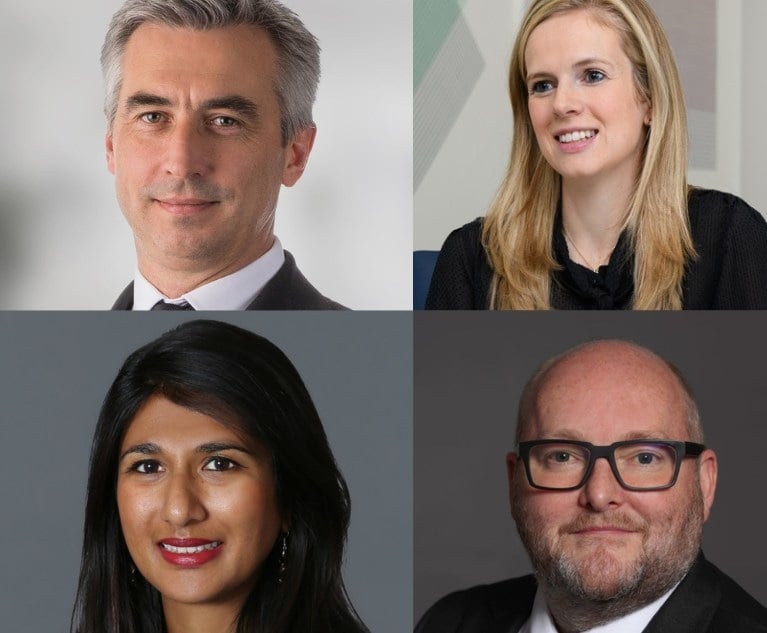After a Banner Year for Law Firm Moves, What's in Store for 2019?
The continued Big Law free agent era will have consequences for top- and mid-tier firms alike in 2019.
December 27, 2018 at 03:09 PM
5 minute read

By at least one measure, 2018 proved to be the busiest year in the past half decade for the ever-shuffling partnerships that make up the Am Law 100.
According to data from ALM Intelligence, more U.S.-based partners left the partnerships of the nation's 100 largest firms this year than in any year since at least 2013, the earliest time such data was available. There were 1,859 such departures through mid-December this year, beating out the previous high-water mark of 1,851 in 2015. Partner additions, too, were up, reaching 1,185 by mid-December; up from 1,175 a year ago.
While partner departures and additions are not a perfect corollary for lateral moves, recruiters said the year saw a boom in partners transitioning between law firms. The Big Law free agent era continued in full swing in 2018, and recruiters expect a similarly busy year of signings in 2019. But it won't come without consequences.
The economics and culture of the country's top partnerships, some recruiters said, will be tested as compensation from lower-producing lawyers will be transferred to highly compensated recruits. Other firms will deal with the natural fallout from that, as lower-paid partners at top firms will move on to new firms.
“Every search firm was probably busy to capacity, if not over, this year,” said Kay Hoppe, a veteran Chicago-based legal recruiter. “There were laterals at every single level moving at every level of firm.”
Clues as to the strength or weakness of the lateral market in 2019 will appear shortly. The first quarter of the year is typically the busiest season for lateral moves. That is when 35 percent of all partner departures from the U.S. offices of Am Law 100 firms have occurred over the past five years. True to form, last year's first quarter set a record for departures in any quarter since 2013. The usual lateral moves are buoyed by retirements, which also often cluster around the new year.
MORE: A by-the-numbers breakdown of six years' worth of partnership moves.
No firm came out of the gate quicker in 2018 than the one that managing partners have eyed with a mixture of envy and caution for the past few years: Kirkland & Ellis.
In January, Kirkland hired Christian Atwood, a former co-chair of the private equity group and a member of the executive committee at Choate Hall & Stewart, and Adam Petravicius, former head of intellectual property transactions, sourcing and technology at Jenner & Block in Chicago.
But the biggest news to start the year came when the Chicago-based giant hired Cravath, Swaine & Moore's Eric Schiele. The then-43-year-old M&A partner was, at the time, the third Cravath partner to join Kirkland. He joined Sarkis Jebejian (a 2012 Cravath departee) and Jonathan Davis (2016). But he was not the last: Star litigator Sandra Goldstein made the Cravath-to-Kirkland move in April.
That these Cravath partners see the pasture as greener at Kirkland is indicative of a broader threat facing the traditional Wall Street elite. Non-lockstep firms are often able to offer these venerable firms' partners double their former pay. And that is causing concern. Veteran Big Law recruiter Mark Jungers calls it “the Kirkland Effect.”
“These firms are now being forced to change, and that is the Kirkland effect,” said Jungers, of Lippman Jungers. “They have some defense mechanisms, like pensions. But what do you do? You have to change.”
Those changes are not only playing out at Wall Street firms, where discussions of changes to lockstep compensation models have been occurring. They extend to less-rigorous compensation systems, where firms are now exaggerating the spread between the highest and lowest earners, Jungers said.
In order to pay partners yearly salaries that approach or eclipse $10 million a year, Jungers said, some firms have lowered the salaries of partners lower on the totem pole. That creates a cultural problem at firms that have an implicit “deal” that treats partners roughly the same.
“Now that the economics are more compelling at a handful of other firms, at least at this moment in time, that is creating a whole lot of uncertainty in the market,” Jungers said. “And that further drives moves. Anyone who is at the top of one of these firms—and there are a lot of those people—instead of just working, now they are thinking about this.”
That is only the top end of the law firm pyramid, though. Exaggerated pay spreads at top firms can also have a ripple effect throughout the lateral market as lower-compensated partners at those firms seek new platforms. If you're robbing Peter to pay Paul, Peter isn't likely to stick around much longer.
That will create a broader question in the 2019 market: How will mid-tier Am Law firms value partners from top firms? Will they pay top dollar for the brand-name boost associated with a new partner?
“You've got a lot of really good lawyers out there who aren't necessarily the ones that will move big business,” Hoppe said. “One of the challenges going forward will be: How do you price them? It doesn't matter what your wife thinks or what your mother thinks. The market will determine what you're worth.”
This content has been archived. It is available through our partners, LexisNexis® and Bloomberg Law.
To view this content, please continue to their sites.
Not a Lexis Subscriber?
Subscribe Now
Not a Bloomberg Law Subscriber?
Subscribe Now
NOT FOR REPRINT
© 2025 ALM Global, LLC, All Rights Reserved. Request academic re-use from www.copyright.com. All other uses, submit a request to [email protected]. For more information visit Asset & Logo Licensing.
You Might Like
View All

Trending Stories
- 1How Law Firms Can Make Business Services a Performance Champion
- 2'Digital Mindset': Hogan Lovells' New Global Managing Partner for Digitalization
- 3Silk Road Founder Ross Ulbricht Has New York Sentence Pardoned by Trump
- 4Settlement Allows Spouses of U.S. Citizens to Reopen Removal Proceedings
- 5CFPB Resolves Flurry of Enforcement Actions in Biden's Final Week
Who Got The Work
J. Brugh Lower of Gibbons has entered an appearance for industrial equipment supplier Devco Corporation in a pending trademark infringement lawsuit. The suit, accusing the defendant of selling knock-off Graco products, was filed Dec. 18 in New Jersey District Court by Rivkin Radler on behalf of Graco Inc. and Graco Minnesota. The case, assigned to U.S. District Judge Zahid N. Quraishi, is 3:24-cv-11294, Graco Inc. et al v. Devco Corporation.
Who Got The Work
Rebecca Maller-Stein and Kent A. Yalowitz of Arnold & Porter Kaye Scholer have entered their appearances for Hanaco Venture Capital and its executives, Lior Prosor and David Frankel, in a pending securities lawsuit. The action, filed on Dec. 24 in New York Southern District Court by Zell, Aron & Co. on behalf of Goldeneye Advisors, accuses the defendants of negligently and fraudulently managing the plaintiff's $1 million investment. The case, assigned to U.S. District Judge Vernon S. Broderick, is 1:24-cv-09918, Goldeneye Advisors, LLC v. Hanaco Venture Capital, Ltd. et al.
Who Got The Work
Attorneys from A&O Shearman has stepped in as defense counsel for Toronto-Dominion Bank and other defendants in a pending securities class action. The suit, filed Dec. 11 in New York Southern District Court by Bleichmar Fonti & Auld, accuses the defendants of concealing the bank's 'pervasive' deficiencies in regards to its compliance with the Bank Secrecy Act and the quality of its anti-money laundering controls. The case, assigned to U.S. District Judge Arun Subramanian, is 1:24-cv-09445, Gonzalez v. The Toronto-Dominion Bank et al.
Who Got The Work
Crown Castle International, a Pennsylvania company providing shared communications infrastructure, has turned to Luke D. Wolf of Gordon Rees Scully Mansukhani to fend off a pending breach-of-contract lawsuit. The court action, filed Nov. 25 in Michigan Eastern District Court by Hooper Hathaway PC on behalf of The Town Residences LLC, accuses Crown Castle of failing to transfer approximately $30,000 in utility payments from T-Mobile in breach of a roof-top lease and assignment agreement. The case, assigned to U.S. District Judge Susan K. Declercq, is 2:24-cv-13131, The Town Residences LLC v. T-Mobile US, Inc. et al.
Who Got The Work
Wilfred P. Coronato and Daniel M. Schwartz of McCarter & English have stepped in as defense counsel to Electrolux Home Products Inc. in a pending product liability lawsuit. The court action, filed Nov. 26 in New York Eastern District Court by Poulos Lopiccolo PC and Nagel Rice LLP on behalf of David Stern, alleges that the defendant's refrigerators’ drawers and shelving repeatedly break and fall apart within months after purchase. The case, assigned to U.S. District Judge Joan M. Azrack, is 2:24-cv-08204, Stern v. Electrolux Home Products, Inc.
Featured Firms
Law Offices of Gary Martin Hays & Associates, P.C.
(470) 294-1674
Law Offices of Mark E. Salomone
(857) 444-6468
Smith & Hassler
(713) 739-1250











